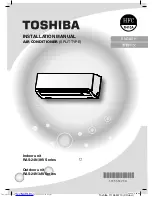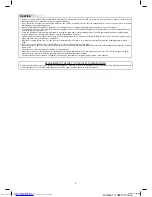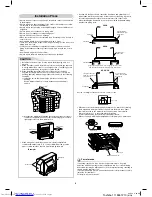
10
Toshiba 1115551210 (EN)
Evacuating
After the piping has been connected to the indoor unit, you can perform
vacuuming together at once.
Using a vacuum pump
Be sure to use a vacuum pump with counter-fl ow prevention function so
that inside oil of the pump does not fl ow backward into pipes of the air
conditioner when the pump stops.
(If oil inside of the vacuum pump enters the air conditioner, which use
R410A, refrigeration cycle trouble may happen)
1. Connect the charge hose from the manifold valve to the service port of the
packed valve at gas side.
2. Connect the charge hose to the port of the vacuum pump.
3. Open fully the low pressure side handle of the gauge manifold valve.
4. Operate the vacuum pump to start evacuating. Perform evacuating for
about 15 minutes if the piping length is 20 meters (15 minutes for 20
meters) (assuming a pump capacity of 27 liters per minute). Then confi rm
that the compound pressure gauge reading is –101 kPa (–76 cmHg).
5. Close the low pressure side valve handle of the gauge manifold valve.
6. Open fully the valve stem of the packed valves (both gas and liquid
sides).
7. Remove the charging hose from the service port.
8. Securely tighten the caps on the packed valves.
VACUUMING
Evacuate the air in the connecting pipes and in the indoor unit using a
vacuum pump. Do not use the refrigerant in the outdoor unit. For details, see
the manual of the vacuum pump.
• After the installation work, be sure to check for gas leaks of the pipe
connections with nitrogen.
• Pressure of R410A is higher than that of R22 (Approx. 1.6 times).
Therefore, using a torque wrench, tighten the fl are pipe connecting
sections that connect the indoor/outdoor units at the specifi ed tightening
torque.
Incomplete connections may cause not only a gas leak, but also trouble
with the refrigeration cycle.
Do not apply refrigerant oil to the fl ared surface.
(Unit : N·m)
Outer dia. of copper pipe
Tightening torque
∅
9.52 mm
33 to 42 (3.3 to 4.2 kgf·m)
∅
15.88 mm
68 to 82 (6.8 to 8.2 kgf·m)
CAUTION
1. Do not put the crescent wrench on the cap or cover.
The valve may break.
2. If applying excessive torque, the nut may break according to some
installation conditions.
CAUTION
•
KEEP IMPORTANT 5 POINTS FOR PIPING WORK.
(1) Take away dust and moisture (inside of the connecting pipes).
(2) Tighten the connections (between pipes and unit).
(3) Evacuate the air in the connecting pipes using a VACUUM PUMP.
(4) Check gas leak (connected points).
(5) Be sure to fully open the packed valves before operation.
Flare at indoor unit side
Flare at outdoor unit side
(Inside unit)
Pressure gauge
Gauge manifold valve
–101 kPa (–76 cmHg)
Handle Low
Compound pressure gauge
Vacuum pump
Handle Hight
(Keep fully closed)
Charge hose
(For R410A only)
Vacuum pump adapter for
counter-fl ow prevention
(For R410A only)
Packed valve at gas side
Charge hose
(For R410A only)
Charge port
(Valve core (Setting pin))
TO CHARGE REFRIGERANT
Refrigerant
24 Class
Non refrigerant charging
Less than 20 m
Refrigerant charging
21 – 30 m (30g/m)
NO GOOD
Cover
Cap
Cover
Piping valve
Cap
Tightened
Loosened
Flare nut
Valve at gas side
A
H
Hexagon wrench
is required.
Service Port Cap
Valve Rod Cap
Packed valve handling precautions
•
Open the valve stem all the way out, but do not try to open it beyond the
stopper.
Pipe size of Packed Valve
Size of Hexagon wrench
12.70 mm and smallers
A = 4 mm
15.88 mm
A = 5 mm
•
Securely tighten the valve cap with torque in the following table:
Cap
Cap Size (H )
Torque
Valve Rod
Cap
H17 - H19
14~18 N·m
(1.4 to 1.8 kgf·m)
H22 - H30
33~42 N·m
(3.3 to 4.2 kgf·m)
Service
Port Cap
H14
8~12 N·m
(0.8 to 1.2 kgf·m)
H17
14~18 N·m
(1.4 to 1.8 kgf·m)
TSB 1115551210_EN.indb 10
TSB 1115551210_EN.indb 10
6/18/14 9:03 AM
6/18/14 9:03 AM













































